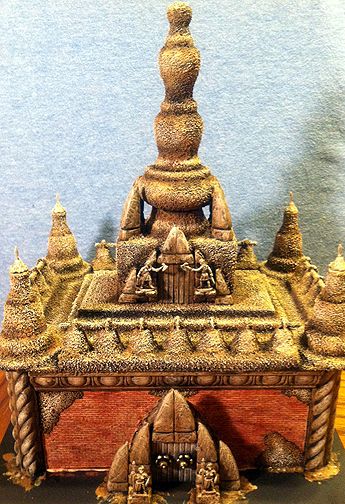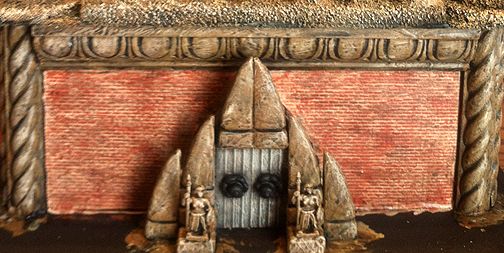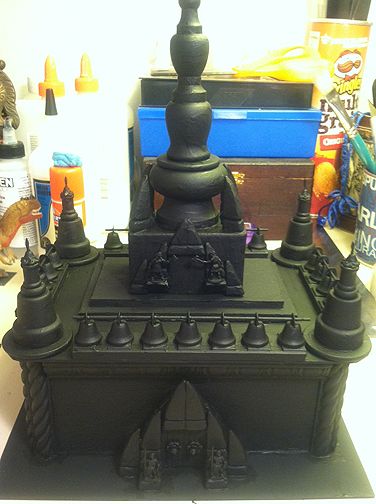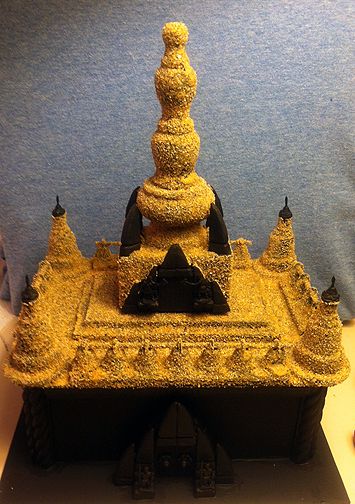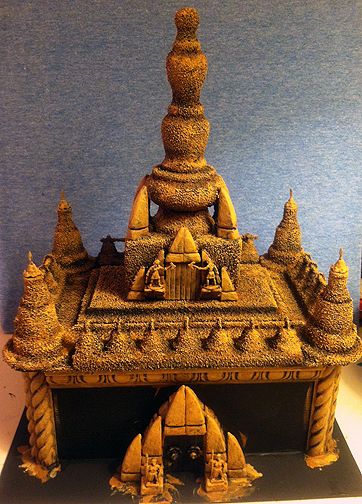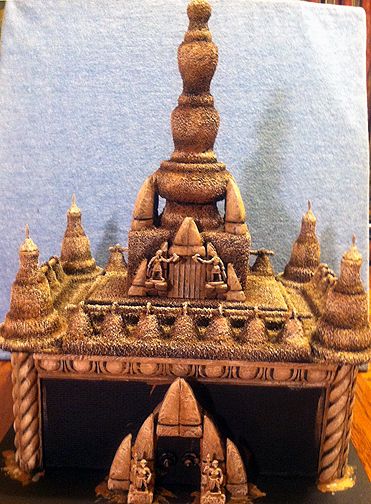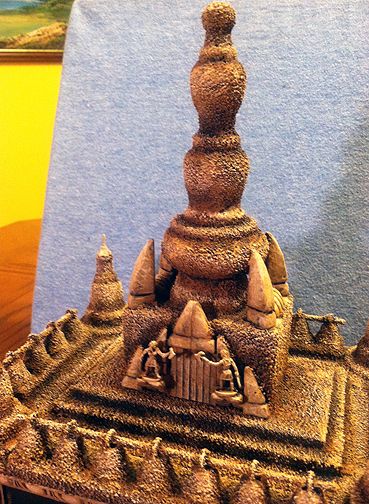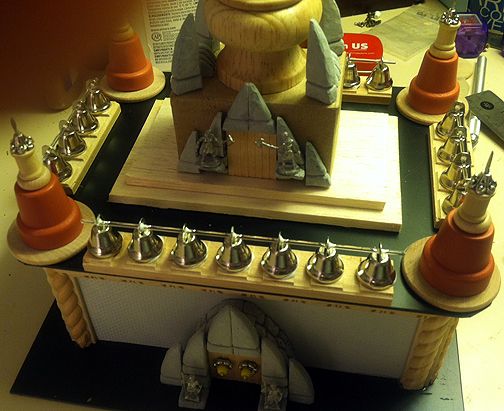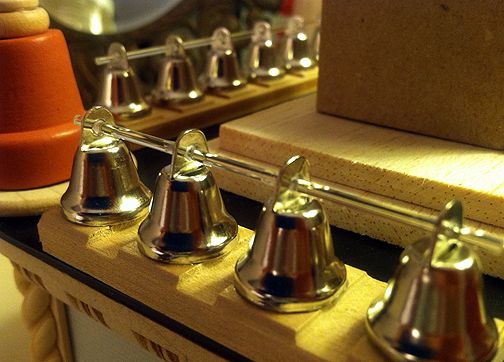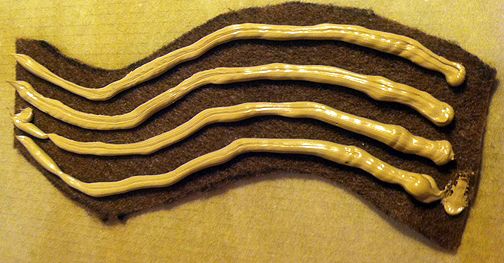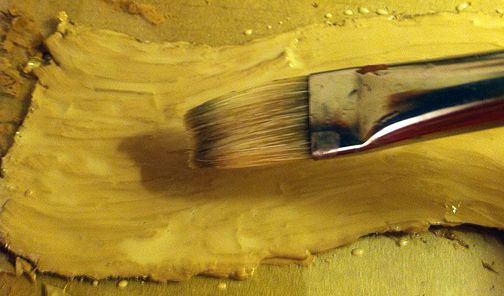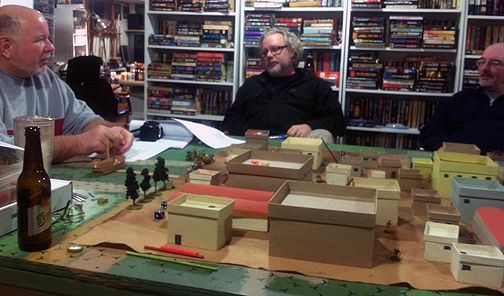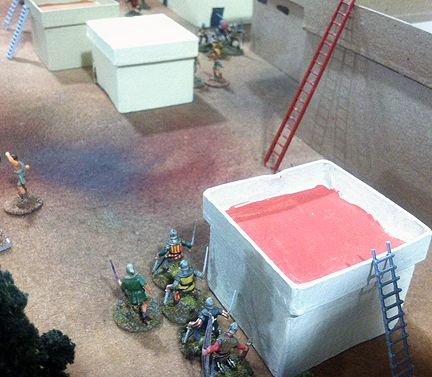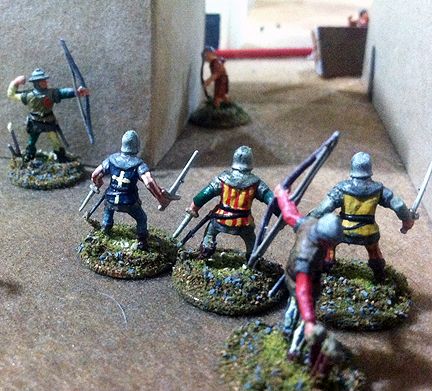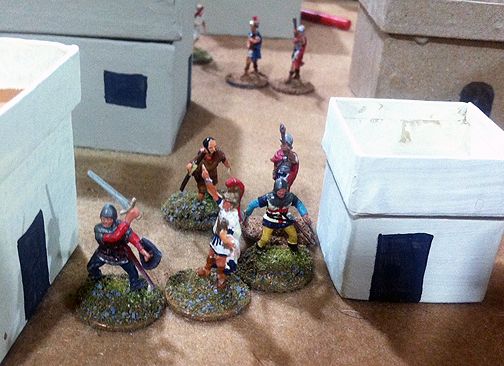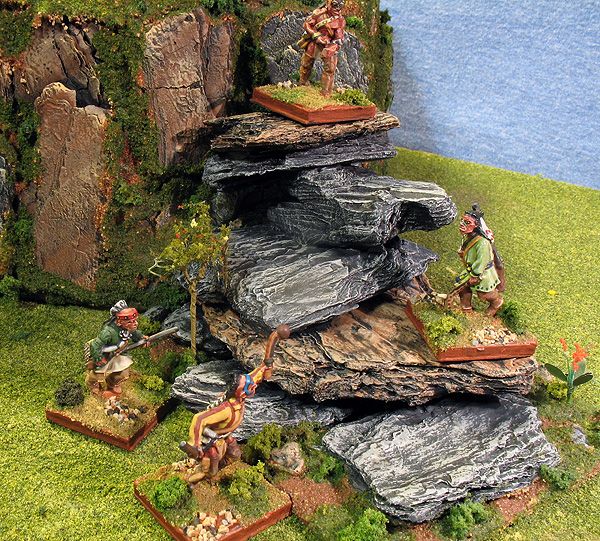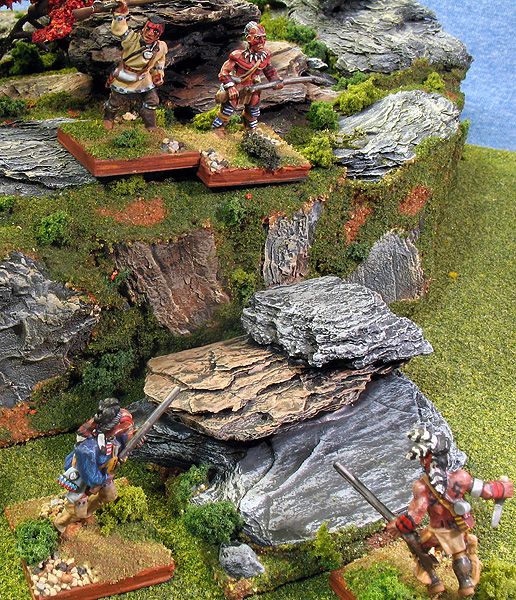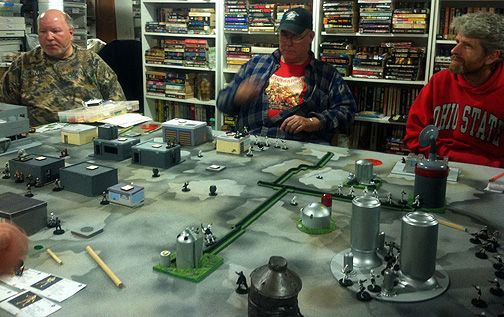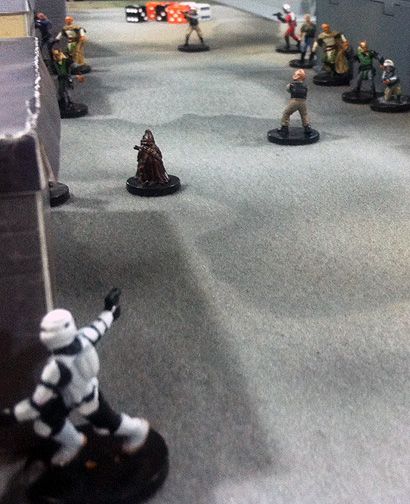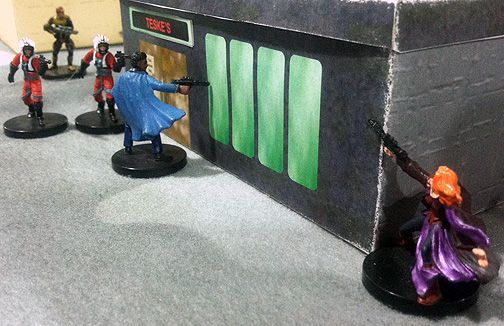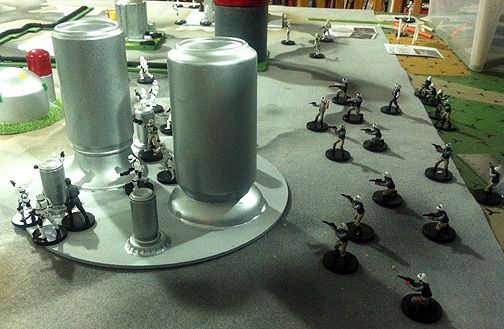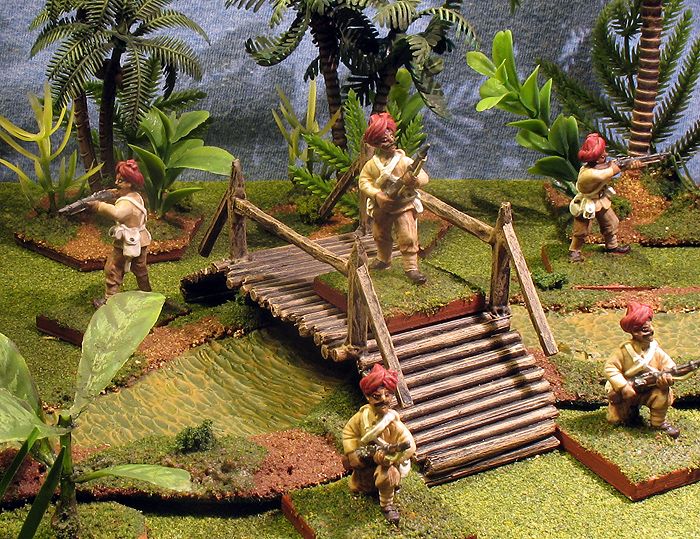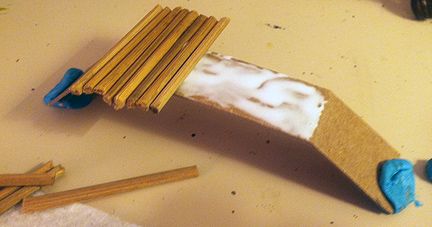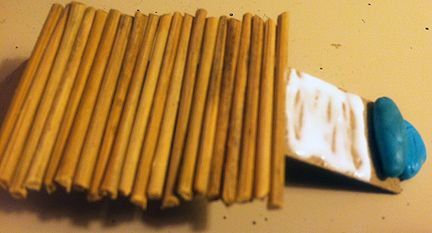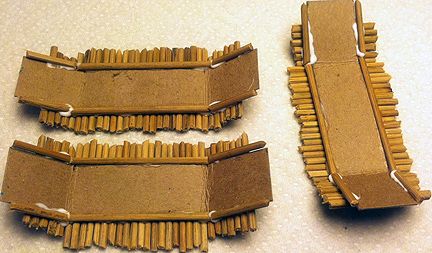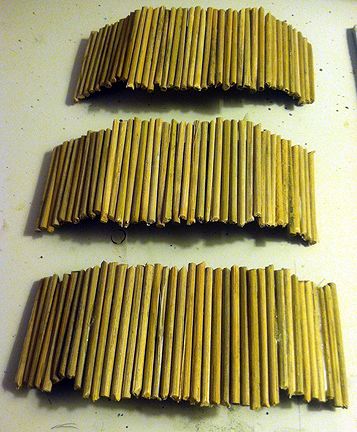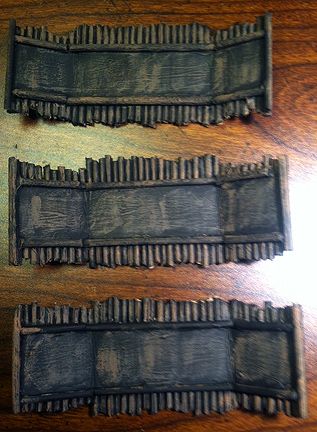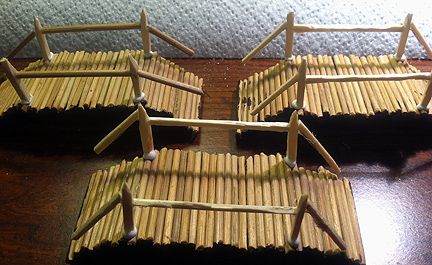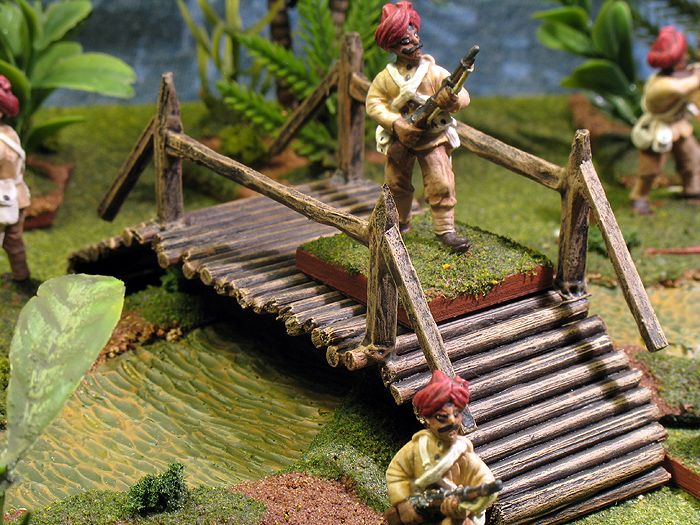 |
| The big one -- at least as far as my Southeast Asian temples will go -- after two days of construction. The only thing left before painting is to find some sort of fancy bead to put along the roof edges inside those squares on the wood trim. |
What do you do when snow cancels gaming, and the next two days of school? Why, build something as far away from Midwestern snowscapes as possible — a temple in the steamy jungles of Southeast Asia! I’d planned all along to build a big temple to go with the two smaller ones and the stupa I’d constructed last year. And I guess it was “next” in line for terrain I’m building for my 28mm Pulp games — Dakota Smith’s Oriental Adventures. So, as I sat around the house Sunday night moping because there was no gaming, I figured I may as well get started on it.
 |
| The walls of this temple would have a brick pattern, courtesy of a great find at Hobby Lobby! |
I had a 4”x6” paper mache box to use as the core of the temple. Unlike the other boxes I used for the temples, this one did not have a patterned surface. Instead, this was plain because I was going to give it brick walls. Many of the temples at Bagan in Myanmar (the inspiration for my temple complex) are made out of brick. The plaster or other surface has worn away on many, so when I visited the complex back in 2003, you see a lot of reddish-orange brick. What’s more, I’d picked up a half dozen patterned, styrene sheets on clearance at Hobby Lobby earlier last year. They included two sizes of brick ones.
 |
| A 4"x6" paper mache box with rectangles of brick-patterned styrene epoxied onto it |
I chose one with the smaller bricks and cut out four rectangles to cover each face of the box. I used two-part epoxy to attach it to the paper mache because I was worried about the styrene not sticking with white glue or Tacky glue. I attached one face at a time so they would not shift on me. The problem with simply gluing a patterned sheet to a box is, of course, the corners. How do you cover up the place where two sheets are supposed to join up? I decided to use an “L-shaped” piece of bass wood and attach it to each corner. That way, it would cover up the seam (or lack of a seam) completely. It was actually hard to find the L-shaped bass wood, and I had to resort to the somewhat pricey local Hobbyland.
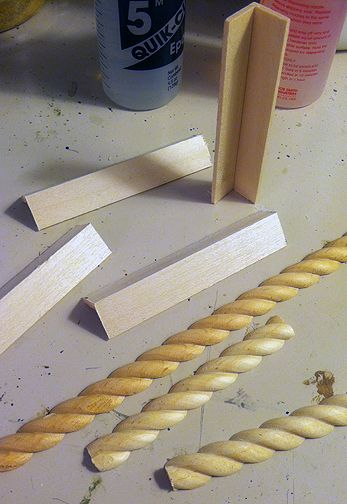 |
| How do you cover up those ugly joins between the four pieces of brick styrene? First cover them with L-shaped bass wood... |
 |
| ...and then you decorate it with wood trim to look like half-columns! |
Each side of the bass wood is 1/2” long, and I decided to decorate that blank space with some fancy wood trim. I’d picked up a large back of various styles of decorative wood trim at Hobby Lobby when I made the first batch of temples. I found two pieces that were perfect and looked like spiral half columns once glued to the building. I actually, put the trim on the L-shaped bass wood first, before I affixed it to the building. That let me use gravity to keep it from sliding while the Tacky glue dried. I took another piece of decorative trim and lined the top edge of the building on all four sides, too. I liked the look of the temple so far, so set it aside to dry while I began working on the roof.
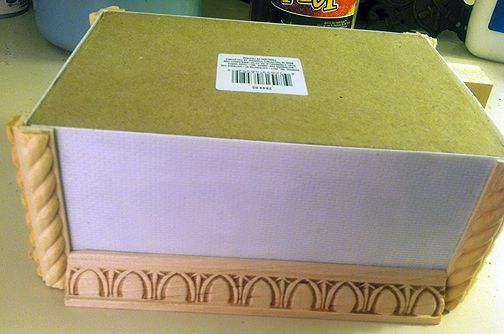 |
| The core of the temple upside-down, so the top trim can dry flush and level |
The base of the roof would be a simple sheet of black styrene. To keep it in place atop the temple, I cut out a piece of balsa wood the exact size of the four walls and glued to the bottom of the roof. The balsa projects down into the walls keeping it from sliding around while the styrene sits atop. While that was drying, I began working on the decorations for the roof. I wanted a bell-shaped projection atop each corner. So, I dug out my miscellaneous wood bits. By assembling an upside down flower pot, spool, disk, wooden wheel, a bead, and a 15mm spear, a very nice looking corner “mini-stupa” was created. The central, bell-shaped decoration was started, as well. It was a bit simpler and consisted of a filial, upside down wooden pot, and a disk.
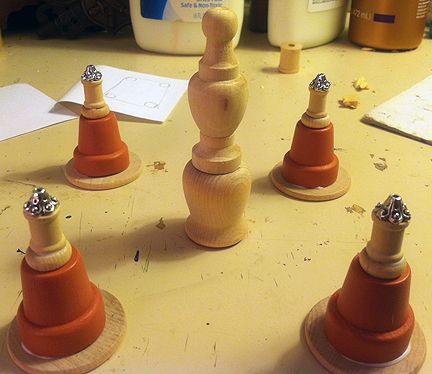 |
| The decorative bits for the roof: Four mini-stupas for each corner, and the central stupa (which will get another layer and grow even taller the next day when I find a piece to go beneath it at Hobby Lobby...!) |
The next day, I took another look at my favorite picture of Bagan, and decided the roof needed to get even fancier. I decided to have a small, false upper level complete with door and roof. So, it was back to Hobby Lobby for their smallest paper mache box. I also picked up another decorative layer to add to the roof’s stupa — a flat-topped doorknob shaped piece of wood that the filial and disk would fit perfectly atop. I used Tacky glue to attach the corner mini-stupas to the roof, and cut two telescoping “levels” of balsa wood for the false second level to sit atop. I had to weight the balsa wood with glue bottles and other miscellanea to keep it flat, though, as balsa tends to warp. It was thickest material I had, though, so I decided to use it. While that was drying, I cut four more sections of decorative wood trim to go along the edge of the roof. It has a square pattern on it, and I hope to find some kind of bead that will look cool in the middle of each square.
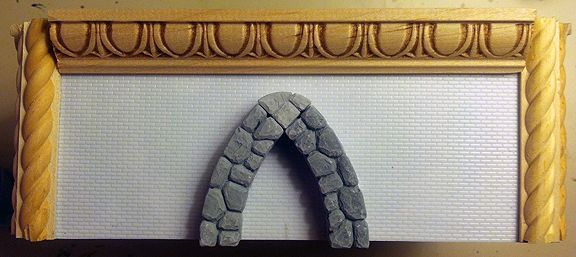 |
| The beginning of the entranceway -- a stone archway made from Hirst Arts curved wall pieces |
Next, it was time to begin work on the doors themselves, the false one on the second level and the main entrance. I had cruised the aisles of Hobby Lobby when I bought the box, hoping for inspiration. I hadn’t seen anything that struck my fancy, though. Eventually, I pulled out my leftover Hirst Arts blocks from when I built my Pictish broch years ago. I fiddled with various bits until something finally game to me. I would use two curved wall sections to form an arching entranceway. Attached to their front would be the door, and some flaring, decorative stone work. Many of the entrances at Bagan have pointed, decorative, arch-like entrances. I was trying to give the effect without exactly copying one. Serendipity struck when the piece I used to get it all together had a projecting stone on either side of the doorway. I looked at it, and said, “Hmmm….a statue would look great there!” I rummaged through my unpainted lead pile until I found two Khmer Maiden Guard figures. They fit perfectly on the stone ledges. The door itself was simply “scalloped” balsa wood. The ornamental door knockers were a couple beads and a pin head glued to the wood.
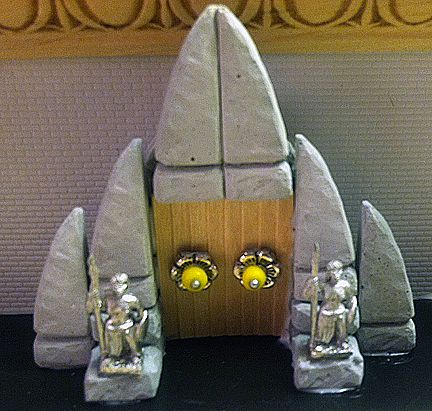 |
| More Hirst Arts pieces attach to the carved stone entranceway (hidden here). The door is a piece of scalloped balsa wood with two beads and a pin head attached. The statues are 15mm Khmer Maiden Guard figures. |
I decided to do a smaller version of the fancy entranceway for the false second floor, too. I left off the door knockers, since the door was only decorative. I used smaller Hirst Arts pieces and was able to give them a stone ledge, too. I dug through my figure box and found — believe it or not — two female zombie hunter figures with axes to guard this entrance. So much of a project like this is work on something, set it aside to dry, and work on another phase or section of the build. I was bouncing between the main temple piece and the roof piece with regularity.
 |
| The roof with most of its construction done. The false level attaches to that block of foam core snugly, allowing me to remove it and store it on its side. The tower mini-stupas have their 15mm spear points glued inside the bead. The only thing missing is some sort of fancy bead in each of those rectangles on the wooden trim along the edge of the roof. |
Once it came time to finish the main entranceway, I had to glue the entire building down onto its styrene base. The roof was progressing well, too. One key consideration is that I want these buildings to fit in the 13”x13”x4” snap-together boxes I use to cart my terrain around. The tough part is always the 4” high part! So, I designed this temple to be three separate pieces. there is the main building, which is about 3” tall. The roof comes apart in two sections. The false second level and the stupa tower atop it pulls off, and can be laid on its side in the boxes. The roof itself is only one layer styrene, two layers of balsa, and a layer of foam core that the false level snugly fits around. It is just a little over 2” tall — most of that being in the corner, “mini-stupas.”
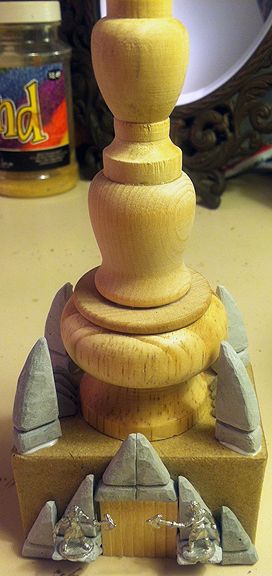 |
| And here is the more than 6" tall false level and stupa tower. I love how you can stack a bunch of these wood pieces on top of each other and it really looks like a stupa from Bagan! A small paper mache box forms the core of the false level, decorated by Hirst Arts pieces and a fake door. Two axe-wielding women guard the fake door. |
All three pieces have been set aside to dry. The only thing left, construction-wise, is some form of decoration on the wood trim on the first level of the roof. I plan on going to Michaels craft store tomorrow and find some cool-looking bead to glue along the roof…well, make that 20 of them!






